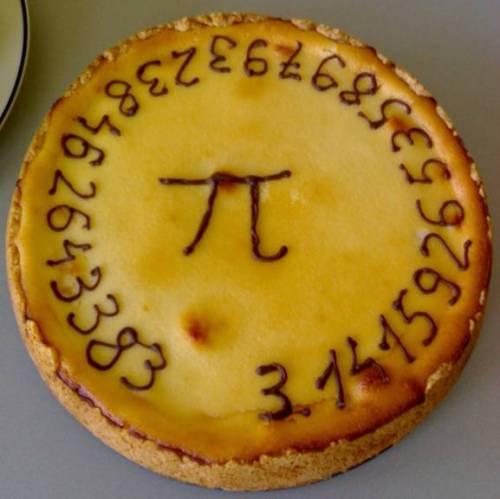Hello. We started this blog in March last year and now we’re really close to finding out why e
Hello. We started this blog in March last year and now we’re really close to finding out why every single day is BRILLIANT. So we’d just like to say a huge thank you to everyone who has read, liked and re-posted our sometimes excessively long ramblings. It’s been a lovely thing to reach so many people across the world from our small corner of rural North Yorkshire. If we make it, and I think we might, tomorrow will be our last post. If you’re not completely fed up with us pestering you every day about things that happened ages ago, you can also find this blog on Wordpress, along with a short explanation of how it came about, and in which we reveal which of us has actually written all of this on the ’about’ page.Why March 14th is BRILLIANTIrrational and UnknowableToday is Pi Day. A day named in honour of the mathematical constant Pi (π). Pi represents a number that is almost, but not quite 3.14. On this day in 1988, a mathematician called Larry Shaw organised the first big Pi day celebration at the Exploratorium, a public learning laboratory in San Francisco. It seems to have involved staff and members of the public marching around in a circle eating fruit pies and what’s not to like about that?. The date was chosen because when you write March 14th in month/day number format it comes out as 3/14, which are the first three digits of Pi. The celebration rather took off and it is now celebrated in lots of places. You probably remember using Pi in maths at school to work out the perimeter and area of a circle. The outside edge of a circle is the same as its diameter multiplied by Pi. So if you can find out how wide the circle is, you can pretty much find out the size of its circumference by multiplying that number by 3.14. We say pretty much because Pi is a very unusual number. If you knew the diameter and the circumference of the circle and tried to divide one by the other to find out what number Pi actually is, you can’t. Those numbers to the right of the decimal point just keep on going, perhaps for ever, no one is sure. They never settle into a repeating pattern. If, for example, you were to divide a hundred by three, you would get 33.33333… and those threes would go on forever, but that’s a pattern. Pi doesn’t have that. Pi has now been calculated to over thirteen trillion decimal places, and calculations are still going. We still don’t know what it is and can discern no pattern.Pi is, it seems, an unknowable number. It is also an irrational number, which means it cannot be written as a fraction. The closest we can sensibly get is 22⁄7 . This means that there is, surprisingly, a second day on which Pi is celebrated: July 22nd (day/month format: 22/7) is Pi Approximation Day. But we’re having none of it, we have other plans for that day. We are really trying to avoid writing out a big string of numbers in this post, as we find them difficult to look at and don’t want to inflict them on you. But if we tell you that a more accurate definition of Pi is 3.141592, we can also tell you that March 14th 1592 was ultimate Pi day. Not that anyone was aware of it at the time. Everyone was probably far too busy sailing about discovering stuff, watching Shakespeare or dying of plague. The Pi symbol in it’s mathematical sense has only been around for about 250 years.Humans have put a lot of effort into working out the relationship of the size of a circle and its diameter. A circle looks like such a simple thing and it seems as if it should be so easy to work out. Four thousand years ago, the Babylonians measured it as three and one eighth. The ancient Egyptians had it at three and one seventh. Egyptologists and people of a mystical persuasion have long been fascinated by the fact that the height of the Great Pyramid at Giza has the same relationship to the perimeter of its base as the diameter of a circle does to it’s circumference. But we have no idea if this was intentional or just a coincidence. Similarly, some think it significant that the first 144 digits of Pi add up to 666, the alleged ‘number of the beast’ in the Book of Revelation. Archimedes, the ancient Greek mathematician, was so obsessed with trying to work out the value of Pi that he did not notice his city was being invaded by the Romans. His dying words are said to have been: 'Do not disturb my circles’. A sixteenth century mathematician called Ludolph van Ceulen devoted most of his life to calculating Pi to thirty-five decimal places. It was such an achievement that the numbers were engraved on his tombstone. In the nineteenth century, William Shanks calculated the first 707 digits of Pi but, unfortunately, he made a mistake at the 527th place. Luckily he didn’t know about it. The mistake wasn’t spotted until 1944.Now, of course, we have computers on the case, which is why the calculations now run into trillions. The calculation of Pi is actually used as a stress test for computers. But for all the time and power we have devoted to it, we still don’t know the exact number of Pi. We can use it to measure any circle, but we can never know the exactly how big it is. It is pretty accurate though. If you used only the first nine digits of Pi to measure the circumference of the Earth, it would only be out by one quarter inch over 25,000 miles. If you used the first thirty-nine digits of Pi , you could measure the size of the known universe and the error would be less than the width of a hydrogen atom. So trying to figure out what Pi really is probably isn’t anything to do with accuracy anymore. It’s about our obsession with trying to find patterns in things. -- source link
#march 14th#whytodayisbrilliant#pi day#archimedes#great pyramid


